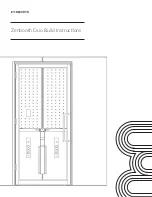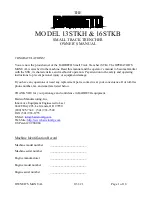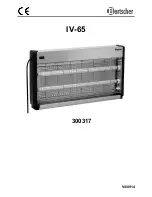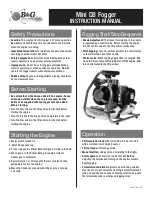
18
4. Once a waveform is digitized, it can be stored in
long-term memory by pressing the
SAVE ALL
or
SAVE CH2
switches. The
SAVE CH2
switch
immediately stores the channel 2 waveform. The
SAVE ALL
switch immediately freezes the display
and stores both waveforms. Once a waveform is
stored by engaging either of these switches, it will be
stored until the switch is disengaged or the power is
turned off.
N O T E S
Any of the operating modes previously dis-
cussed in analog operation (e.g.
DUAL, ADD,
etc.) can be used in digital mode, except for
X–Y operation.
Time base settings of 10 µs/div and faster result
in a display that is acquired through “equivalent
time sampling”. This process develops the
digitized image over many cycles of the
repetitive signal; therefore, these higher sweep
speeds cannot be used for capture of one-time
events. Equivalent time sampling is discussed
in detail in
Appendix II, “Unique Characteristics of Digital
Storage Oscilloscopes”.
Digitizing One-Time Events
One of the most powerful features of a digital storage
oscilloscope (DSO) is its ability to capture one-time
events. To capture one-time events, single-sweep
operation is employed. This is done through the use of the
SINGLE switch. When pushed, this switch releases the
REFRESH or ROLL mode if previously engaged, and
readies the digital storage circuit to receive a trigger signal
— presumably the event to be captured or some other
time-related occurrence. When the event arrives, it is
stored in the memory and displayed. The procedure is as
follows:
1.
Set the oscilloscope to run in analog mode
(ANA-
LOG/DIGITAL
switch to
ANALOG).
Select
NORM
triggering, and adjust the
TRIG LEVEL
control so that the unit triggers on the event to be
captured.
2.
Set the oscilloscope to digital
(STORAGE)
mode by
engaging the
ANALOG/STORAGE
switch.
3.
Initially, set the
PRE TRIG
switch to 50%. A more
detailed discussion of pre- and post-triggering is
given later in this section of the manual.
4.
Press the
RESET
switch. The
READY
indicator
will momentarily light as the scope awaits the arrival
of the trigger signal. When that trigger occurs, the
READY
indicator will go off, and the event being
monitored will roll to the center of the display and
stop.
N O T E S
Depending on the sweep
TIME/DIV
setting, the anticipated event may roll to the
center of the screen very rapidly, or very slowly,
after the
READY
indicator goes out.
Single-sweep mode can be used in the presence of very rapidly
occurring events, even continuous waveforms if desired. In that
case, the period between pushing the RE-SET switch and the
arrival of the trigger may be very short or almost instantaneous.
As a result, the
READY
indicator may light for only a very
short time, perhaps not being visible at all.
Pushing the
SINGLE
switch automatically disengages
both the
REFresh
and
ROLL
modes, which are
continuous modes.
5.
Once the waveform is captured, it can be stored in long-term
memory through the use of the
SAVE CH2
or
SAVE ALL
switches.
Pre- and Post-Trigger Capture
Another powerful feature of a DSO is ability to display
“pre-trigger” information, that is, events occurring before the arrival
of a trigger event. On the Model 2522C, pre-trigger operation is
available in single-sweep mode by setting the
PRE TRIG
switches.
As shown in the above section on “Digitizing One-Time Events”,
when 50% pre-trigger operation is selected, the event to be captured is
situated in the center of the memory (roughly the center of the display)
after storage. The waveform to the left of center represents activity
which occurred before that trigger arrived. Pre-Trigger selection of
25% and 75% are also available.
If the
PRE-TRIG
switches are released (0% pretrigger), then no
pre-trigger information is stored, and the trigger event rolls to the
extreme left of the display. In this case, all the information displayed
on the screen represents activity after the trigger event. You may
wish to use post-trigger operation first to observe where the trigger is
occurring on the waveform of interest, and then switch to pre-trigger
mode.
Roll Mode
In this mode of operation, the waveform rolls across the CRT from
right to left (as opposed to standard oscilloscopes, which have the trace
moving from left to right) in the same manner as most strip chart
recorders. It is most commonly used for viewing very slow events.
1.
Set up the oscilloscope in analog mode so that the event to be
observed is properly positioned on the display. you may wish to
use
AUTO
triggering so that the scope continues to draw a
trace even if the event is especially slow.
2.
Switch to digital mode
(ANALOG/STORAGE
switch to
STORAGE),
and depress the
ROLL
switch. Select a
TIME/DIV
setting that produces a roll at the desired speed. As
the sweep speed is decreased, the waveform will move across
the screen more slowly and the Roll feature will become more
apparent. It can also be slowed by a factor of 100 on some ranges;
see the discussion in the next section.









































